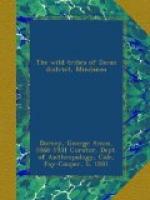[l] Musa textilis.
FIG. 27. HEMP MACHINE.
During ceremonies and at festivals a fermented drink made of sugar cane is served, and in anticipation of its pleasurable effects the Bagobo is willing to expend a considerable amount of effort. The juice of the cane is extracted by means of a press made of two logs arranged in parallel horizontal positions, so that the end of a wooden lever can slip under one and rest in a groove cut in the other (Fig. 28). The cane is placed in the groove and the operator bears his weight on the lever, thus squeezing out the juice. After being boiled with the bark of certain trees and lime juice, the liquor is sealed in jars or bamboo tubes and is stored away until needed.
FIG. 28. SUGAR CANE PRESS.
The sago palm is found in parts of the Bagobo territory, and in times of need, the people make temporary camps near to the sago districts, where they prepare the flour. This is done in the same manner as is fully described on page 140.
The most important thing in the life of the Bagobo is the care of the rice, for on this crop he depends for the greater part of his food supply, and by its condition he can ascertain with what favor he is looked upon by the spirits. So closely is the cultivation of this cereal coupled with the religious beliefs that it is necessary, in this relation, to describe the ceremonies connected with it.
We have previously stated that the incursion of the cogon grass into the fields makes necessary some new clearings each year. In the month of December a constellation known as Balatik appears in the sky. This has a double significance; first, it is the reminder for the yearly sacrifice; and secondly, it notifies all workers that the tools, which are to be used in making new clearings, shall be placed in readiness. All those who expect to prepare new fields for themselves, or are to assist others in such work, gather at the forge of the local smith and there take part in a ceremony held in honor of his patron spirit. They carry with them offerings of rice and chickens which they cook in bamboo tubes, for food taken from a pot is not acceptable to this spirit. When all is ready the food is placed on a rice winnower, near to the forge, and on it the men lay their weapons and working knives (Plate XXIX). Standing before the offering the smith, in a droning voice, calls on the spirit, beseeching him to come and eat of the food, to accept the weapons and tools, and having done so to be watchful over the workers during the clearing time, so that they may not be injured in the work or be molested by enemies. The prayer finished, the smith eats a little of the food, and all the men follow his example, but no woman may so much as touch this offering. Meanwhile other food which can be eaten by all has been prepared. After the meal the weapons and tools which are to be used during the clearing time are removed, but, as they now belong to the spirit, they can never be disposed of without first recompensing him. During this day there is a strict prohibition against music and dancing. For three days the men abstain from work and the forge stands idle. When the fire is again lighted the first knife made is the property of the spirit.




